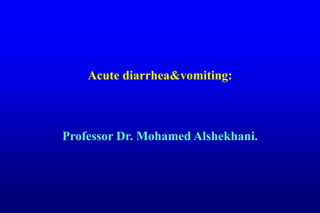Acute diarrhea is caused by infections spread through the fecal-oral route. It affects over 1.7 billion people globally each year and causes 760,000 deaths in children under 5. The key to management is fluid replacement to prevent dehydration through oral rehydration solutions. Antimicrobial treatment is usually not needed for acute infectious diarrhea but may be used for invasive bacteria like Shigella or Salmonella to prevent systemic complications. Proper hygiene and sanitation can help limit the spread of diarrhea-causing illnesses.

















